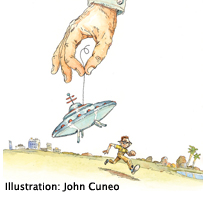Wired’s Guide to Hoaxes: How to Give “” and Take “” a Joke
Essay by Scott Brown, The Official Prankonomy by Steven Leckart
Wired.com
August 24, 2009
 Here’s what you’ve been told: “There’s a sucker born every minute.” “Take or be taken.” “Believe none of what you hear and half of what you see.” These aphorisms are so ingrained in American life, they’re practically commandments. And for good reason: We are a credulous people. For proof, open your spam folder and count the chain emails from 1998 that are still coming in, dutifully forwarded by friends and relatives. Or consider that new Facebook pal whose name seemed familiar enough when you hit Confirm. We are, today, the same easy marks who ran screaming from Orson Welles’ made-up Martians and flocked to see the Cardiff Giant. So we’re defensive. A hoax, we are taught, is an invasive, aggressive stratagem””a nefarious short-circuiting of our natural social instincts, a hack of Trust itself, a deterministic, zero-sum shell game with a clear winner (the prankster) and loser (the gull).
Here’s what you’ve been told: “There’s a sucker born every minute.” “Take or be taken.” “Believe none of what you hear and half of what you see.” These aphorisms are so ingrained in American life, they’re practically commandments. And for good reason: We are a credulous people. For proof, open your spam folder and count the chain emails from 1998 that are still coming in, dutifully forwarded by friends and relatives. Or consider that new Facebook pal whose name seemed familiar enough when you hit Confirm. We are, today, the same easy marks who ran screaming from Orson Welles’ made-up Martians and flocked to see the Cardiff Giant. So we’re defensive. A hoax, we are taught, is an invasive, aggressive stratagem””a nefarious short-circuiting of our natural social instincts, a hack of Trust itself, a deterministic, zero-sum shell game with a clear winner (the prankster) and loser (the gull).
Well, here’s what we’re telling you: Bullshit.
Take and be taken. There’s a skeptic born every minute. Every man a mountebank, every man a mark! These are your new commandments, O children of Barnum, Borat, and Blair Witch. The source of hoodwinkery has shifted from the all-powerful (ad agencies, governments, MTV) to the tweeting masses””and lo, charlatanism is democratized. There is no more Big Lie, only Big Lulz, and getting gamed is no shame. It’s the seal on the social contract, a mark of our participation in this new covenant of cozening.
Raised on a diet of rickrolls, Goatse, and other forms of cultural roughage, we no longer take pranks so personally, and we know that “too far” and “too soon” are a lot farther and sooner than they used to be. We also know it’s fun. For the Hoax Populi, it’s a kind of language””a friendly punch in the arm, not a stab in the back. And we need that social lubricant to keep us (a) safely aware of ourselves and (b) united as a fractious but functional whole.
Still, it’s sometimes hard to distinguish a prank from a scam, a sham from a fraud, a Nigerian prince from Prince Albert in a can. That’s why wired is pleased to present this handy Prankonomy, a celebration of the japes and ruses of our shifty age.
For The Official Prankonomy: From Rickrolls to Malware, a Spectrum of Stunts, by Steven Leckart visit here.
